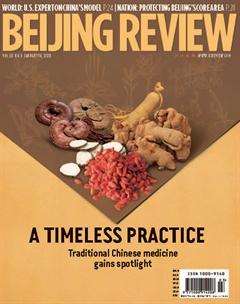Deciphering the RRR Cut
By Lan Xinzhen
When the Peoples Bank of China (PBC), Chinas central bank, cut commercial banks reserve requirement ratio (RRR) by 0.5 percentage point on January 6, a move expected to unleash 800 billion yuan ($115 billion) in the market, many read it as a sign of China relaxing its monetary policy. The central banks efforts were seen as an attempt to stabilize the economy amid the economic slowdown.
However, given Chinas current economic picture, the reading is groundless. Its impossible for China to stimulate its economic growth through this means at this moment.
China has pursued a prudent monetary policy since 2010, a crucial measure by the government to ensure economic transition and upgrading while maintaining stable growth. The goal of economic transition has been partly achieved, and thus the odds of relaxing the monetary policy are low.
A relaxed monetary policy is likely to see some funds fl ow to energy-intensive and polluting industries and the property sector, which could negatively impact the development of industries of high economic value added and hinder the pace of economic transition and upgrading.
Also, the economy does not need to be spiced up by a relaxed monetary policy at the present stage. According to the National Bureau of Statistics, the economic growth rate has been kept at about 6.5 percent in recent years and despite a dip in the fi rst three quarters of 2019, it was still 6.2 percent. This rate can meet the demand of the economic transition, support employment and ensure resident income growth.
More importantly, this growth rate has been achieved on the basis of new economic drivers like Internet Plus, the Internet of Things, big data and cloud computing. The proportion of strategic emerging industries and hi-tech manufacturing has sharply risen in the overall industry.
The economic growth pattern has also been upgraded, with the tertiary industry becoming a major force of growth.
In November 2019, the broad measure of money supply rose by 8.2 percent year on year. To ensure a successful economic transition and stability, and to curb infl ation, the currency circulating in the Chinese market is not stretched yet. Thus there is no ground for relaxing the monetary policy.
The swine flu raised pork prices in 2019, which in turn pushed up the cost of living index. The consumer price index in November saw a year-on-year increase of 4.5 percent, implying a trend of inflation. Relaxing the monetary policy would be likely to trigger infl ation.
The central bank probably has two goals for cutting the RRR. The fi rst is to implement fi nancial policies in a more accurate way to serve the real economy and lower financing costs for micro and small enterprises (MSEs). The second is to increase the fl ow of consumption funds during Spring Festival.
In China, MSEs have difficulty getting bank loans. Though governments at various levels are trying to resolve this issue, fi nancial institutions still fi nd it diffi cult to satisfy the demand for funds from a swelling number of MSEs.
Private enterprises, particularly MSEs, are challenged by the economic downturn and China-U.S. trade friction, and some are in urgent need of funds to cope with current volatilities.
Besides, as people across the country go back home for the traditional family reunion during Spring Festival, enterprises have to pay off debts and wages, another reason for requiring big amounts of cash. The three factors combined cry for an increased fl ow of funds.
The PBC announced on December 23, 2019 that it would consider measures including RRR cuts as well as relending and refi nancing, together with efforts to lower the real interest rate and comprehensive fi nancing costs and help MSEs with easier access to loans. The news of the RRR cut soon followed this announcement.
A clue to current currency policy can be found in the Central Economic Work Conference convened on December 10-12, 2019. It determined stability as the priority of the countrys economic work in 2020, including fi nancial stability and a prudent monetary policy.
Chinas current economic growth is mostly impacted by external factors, not least U.S. unilateralism and trade protectionism. The China-U.S. trade friction has posed uncertainty to economies around the globe. This is not a problem that can be solved through relaxing the monetary policy.
In 2019, the U.S. Federal Reserve adjusted monetary policies several times, which was followed by many major economies in the world. But China is an exception. China has been carrying on with its prudent monetary policy in line with its own economic situation, refl ecting the independence of the Chinese market as well as the resilience and confi dence of the Chinese economy.
Chinas current economic growth is maintained within a reasonable range, a trend that is expected to continue in 2020.

